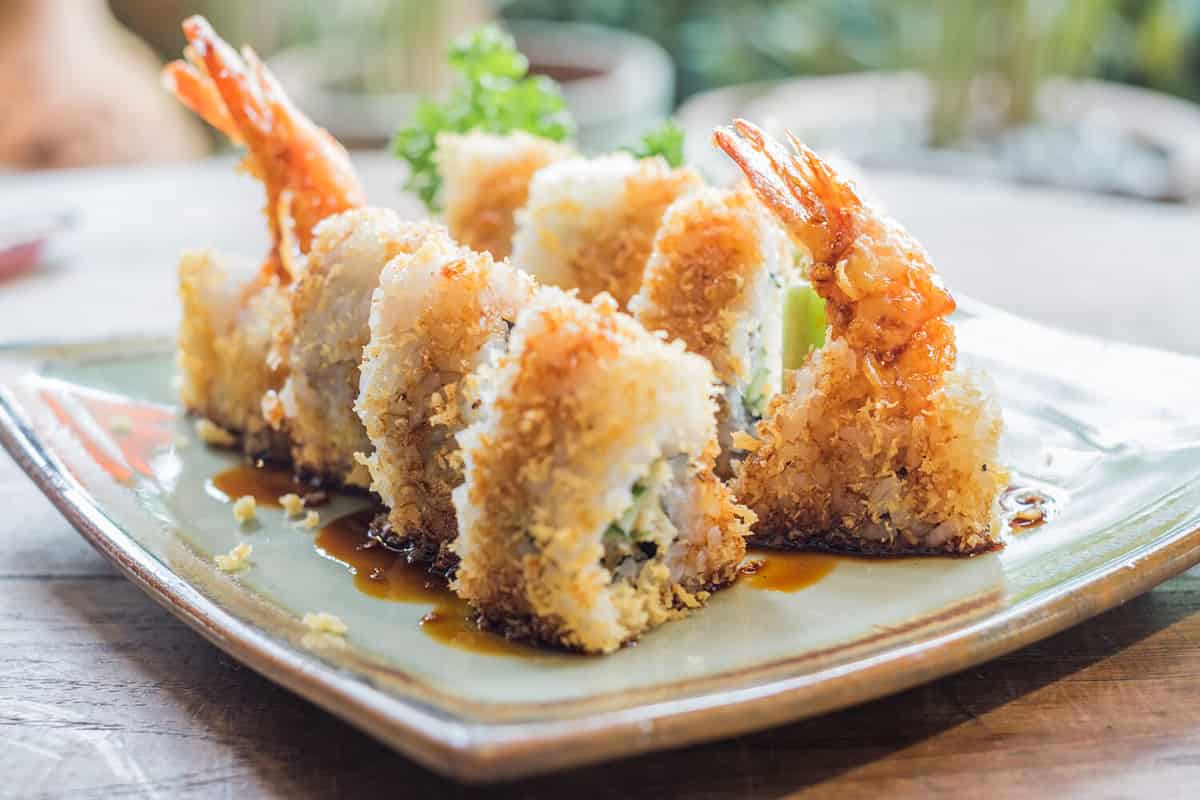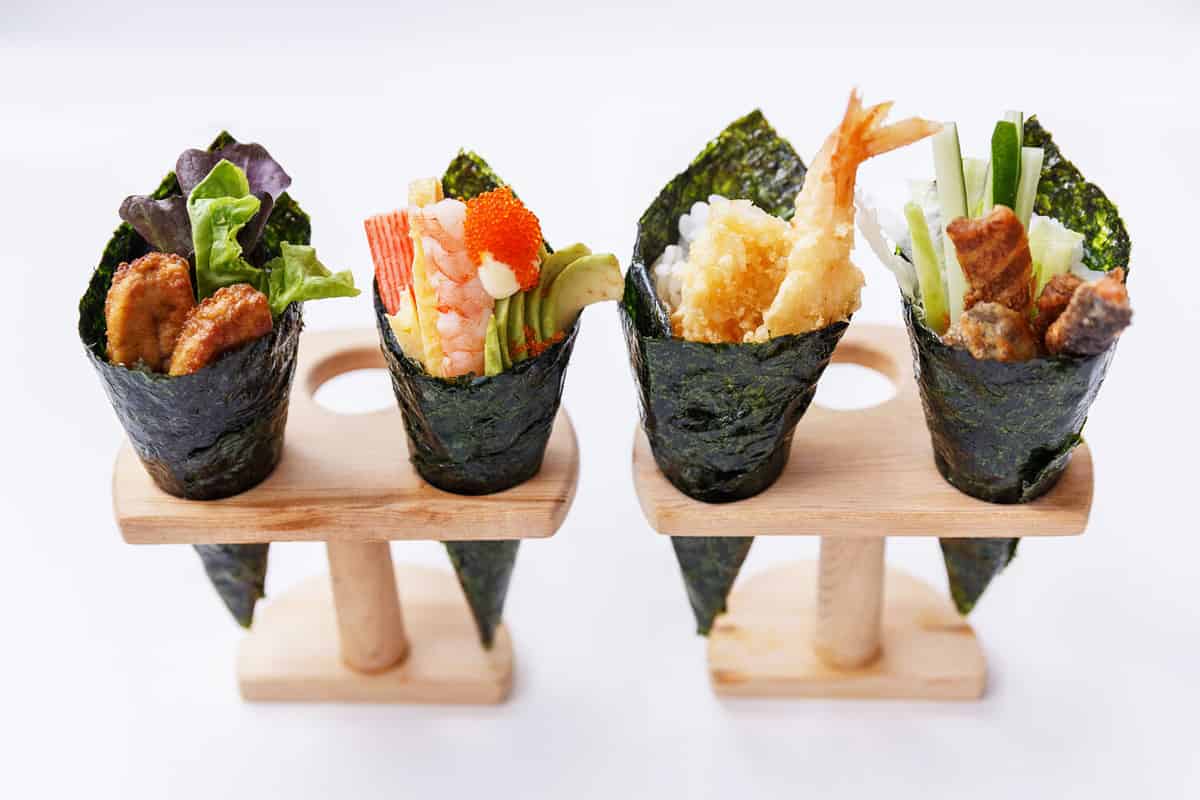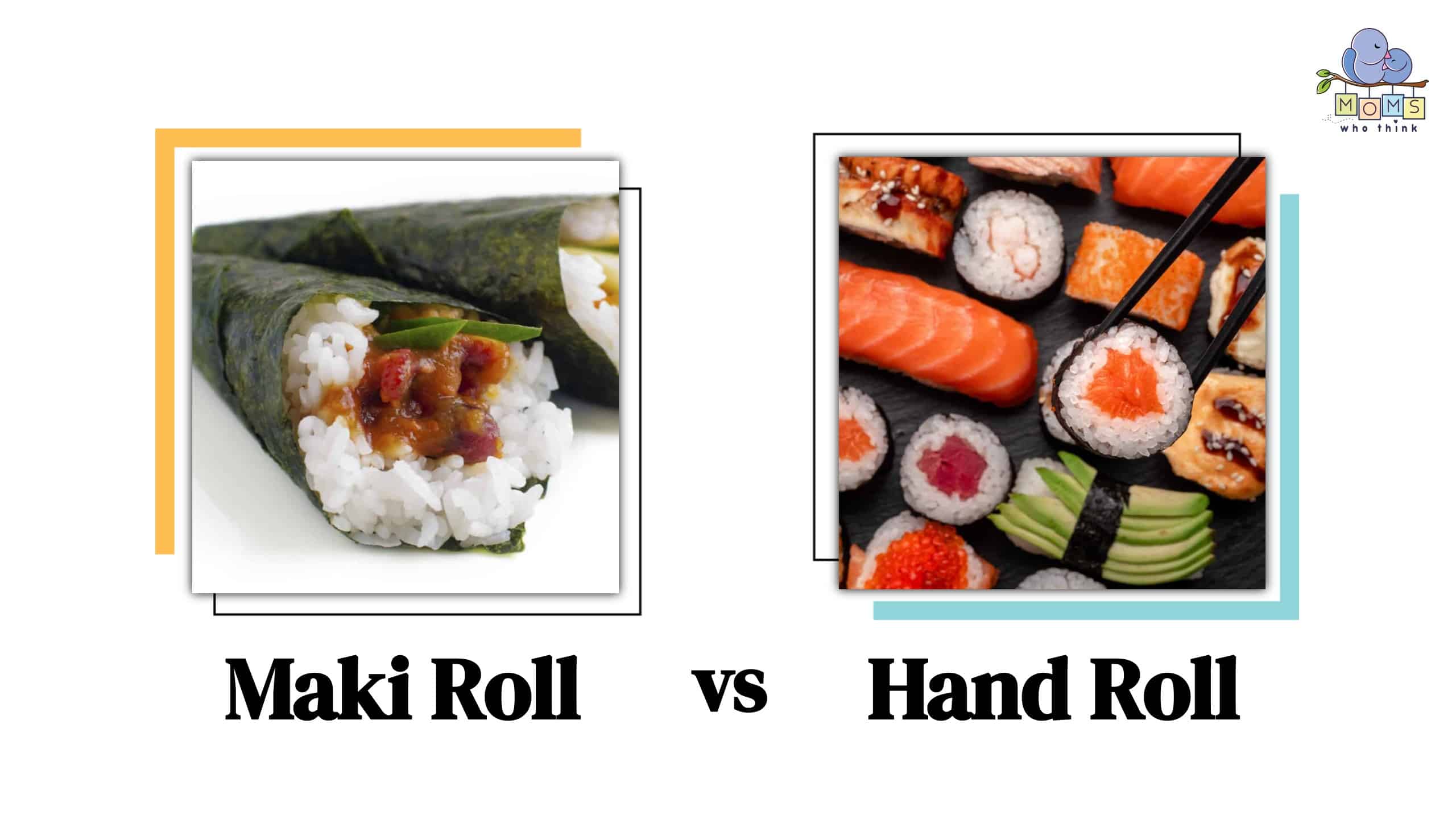Sushi is the perfect light meal for a quick lunch, dinner, or even a midday snack. There are so many types of rolls out there that even if you’re not a fan of raw fish, you can still find a sushi roll you enjoy. Whether you head to a local sushi restaurant or decide to try your hand at making sushi at home, if you come across maki roll and hand rolls, you might wonder about the difference between them.
While maki rolls and hand rolls use the same ingredients, the main difference between them is how they’re made and how they’re eaten. Maki rolls are cut into bite size pieces you can eat with chopsticks while hand rolls are meant to be picked up and eaten with your hands. Maki rolls are small, cylindrical pieces while hand rolls are in the shape of a cone.
If you’re interested in making sushi at home or you’re ordering out and want to learn about the different types of sushi, keep reading to find out more about maki roll vs hand roll.

Maki rolls are cut into bite-size pieces and are the most common type of sushi rolls.
©Pornthep Vongmatavee/Shutterstock.com
Maki Roll vs Hand Roll: What Is the Difference?
Whether you’re new to trying sushi or you’re feeling adventurous and want to make sushi at home, it’s important to know about the different types of sushi rolls. Although maki rolls are the ones you see most frequently, they’re not the only type. Some of the types of sushi include sashimi, temaki, maki, and hand rolls.
There are numerous differences between maki roll and hand roll including their shape, rolling method, and serving size. Maki roll, also known as makizushi, is a type of rolled sushi. The majority of sushi rolls you see in the store or in a sushi restaurant are maki sushi.
On the other hand, a hand roll is a type of sushi that’s rolled into a cone shape and is eaten whole instead of cut into pieces like maki rolls. Both types of sushi rolls can be dipped in soy sauce even though they’re eaten differently.
In some cases, you’ll see hand rolls labeled as a type of maki roll and maki rolls are sometimes also simply called sushi rolls. However, you can tell the difference between them because hand rolls, or temaki, are constructed differently and have a completely different shape. While hand rolls are shaped like a cone and are meant to be eaten with your hands, maki rolls are cut into bite-size pieces and are meant to be eaten with chopsticks.
As far as the nutritional values and ingredients of maki roll vs hand roll, they’re often very similar and might even have the same exact ingredients. Both include seaweed, sushi rice, and at least one filling. The main differences between them has to do with the way they’re made, how they’re eaten, and their shape.
Main Differences Between Maki Roll vs Hand Roll
One of the best parts about eating sushi is the numerous possibilities for different toppings, flavors, and fillings. There are also many different types of sushi. When comparing maki roll and hand roll, here are the main differences between them:
- Maki roll is cut into bite-size pieces
The main difference between these two rolls is their shape and structure. While maki rolls are rolled into a large cylinder and then cut into bite-size pieces, hand rolls are rolled into a cone shape. - Hand roll is meant to be eaten with your hands
Unlike maki roll, which you eat with chopsticks, hand roll is meant to be eaten with your hands. Since it’s rolled into a cone and eaten whole, you can simply pick up a hand roll without chopsticks. - Maki roll requires a bamboo mat
While you can easily learn how to make sushi at home, maki rolls require a bamboo mat, or rolling mat. Hand rolls can simply be rolled by hand.
What Is a Maki Roll?
A maki roll, also known as makizushi, is a type of sushi roll made using a bamboo mat. This type of sushi is rolled up and then cut in cylindrical pieces. Maki means to roll or wrap around in Japanese.
When you make a maki roll, you layer seaweed, sushi rice, and any other ingredients on top of a bamboo mat. Then, you roll it up before cutting the maki roll into smaller bite size pieces. Maki rolls are sometimes just called sushi rolls as well since they’re the most popular type of sushi.
There are many different types of maki rolls you can enjoy with a number of different fillings. Typically this type of sushi roll is filled with raw or cooked fish and vegetables. Some of the most popular types are tuna roll, california roll, volcano roll, or salmon roll. If you’re not a fan of raw fish, you can order a roll with tempura or even one without fish like the avocado roll.

Hand rolls are rolled into a cone or cylinder shape and can be picked up with your hands.
©Artit Wongpradu/Shutterstock.com
What Is a Hand Roll?
Hand rolls, also known as temaki, are a different type of sushi that are rolled into the shape of a cone with the seaweed on the outside. This type of sushi is eaten whole instead of being cut into bite-size pieces like the maki roll.
Generally, hand rolls are rolled into a cone shape or sometimes a long cylinder, depending on the type of roll. Similar to maki rolls, the ingredients and fillings inside the sushi include raw or cooked fish and vegetables.
This sushi is rolled by hand, which makes it easier to make at home if you don’t have access to a bamboo mat. Additionally, you eat hand rolls by picking it up with your hands instead of using chopsticks like you would with maki roll.
Types of Maki Rolls
A maki roll is the most common type of sushi in Japanese cuisine. These rolls include roasted seaweed and sushi or seasoned rice. The ingredients inside the sushi roll can include fish, vegetables, cream cheese, sesame seeds, and many other ingredients depending on your preferences.
While the ingredients of maki rolls can vary greatly, there are several different types of maki rolls. Here are some of the types of maki rolls:
- Hosomaki
- Chumaki
- Futomaki
- Kappamaki
- Tekkamaki
Hosomaki
Hosomaki is a type of maki roll that only has one ingredient for the filling. This is a type of small or thin maki roll.
Chumaki
A chumaki roll is a type of maki roll that’s considered a medium width roll. This type of maki roll has between 2-3 three fillings.
Futomaki
A futomaki roll is a thick sushi roll that contains several different fillings. The name itself means fat sushi roll because of the size compared to rolls with less fillings.
Kappamaki
A kappa maki roll, also known as cucumber roll, is specifically one that has rice, seaweed, and a cucumber based filling. This is a thinner and smaller roll compared to the futomaki roll.
Tekkamaki
Tekka maki, also known as tuna roll, is a type of maki roll with three ingredients like the kappa maki roll. However, the ingredients in the tekka maki roll are sushi rice, seaweed, and tuna.
Types of Hand Rolls
Unlike maki rolls, hand rolls are eaten with your hands instead of chopsticks. They have many of the same ingredients as maki rolls but they have a different shape and are rolled by hand instead of with a bamboo mat.
In some cases, hand roll is a considered a type of maki roll, which is why it’s also called temaki. However, unlike your standard maki roll, it’s rolled into a cone or cylinder by hand.
The ingredients for hand rolls, or temaki rolls, include sushi rice, raw fish, vegetables, and other fillings of your choice.
Some of the most popular ingredients in hand rolls are:
- Salmon
- Tuna
- Crab
- Squid
- Cucumber
- Avocado
No matter what your preference is, hand rolls can be made in a number of different ways. The main difference between them and regular sushi rolls is their shape and how you eat them. Hand rolls are also easier to make at home since you don’t need a bamboo mat or any other special tools.
Best Kinds of Sushi: Maki Roll vs Hand Roll
Choosing which type of sushi roll is the best comes down to your personal preferences. Considering the ingredients in maki rolls and hand rolls are often the same, the main differences between them is their shape and how they’re eaten.
If you order them in a restaurant, you can even try both types of rolls to see which one you enjoy more. As far as making your own sushi at home, hand rolls allow you to roll the sushi by hand while maki rolls require a bamboo mat to roll them properly.

